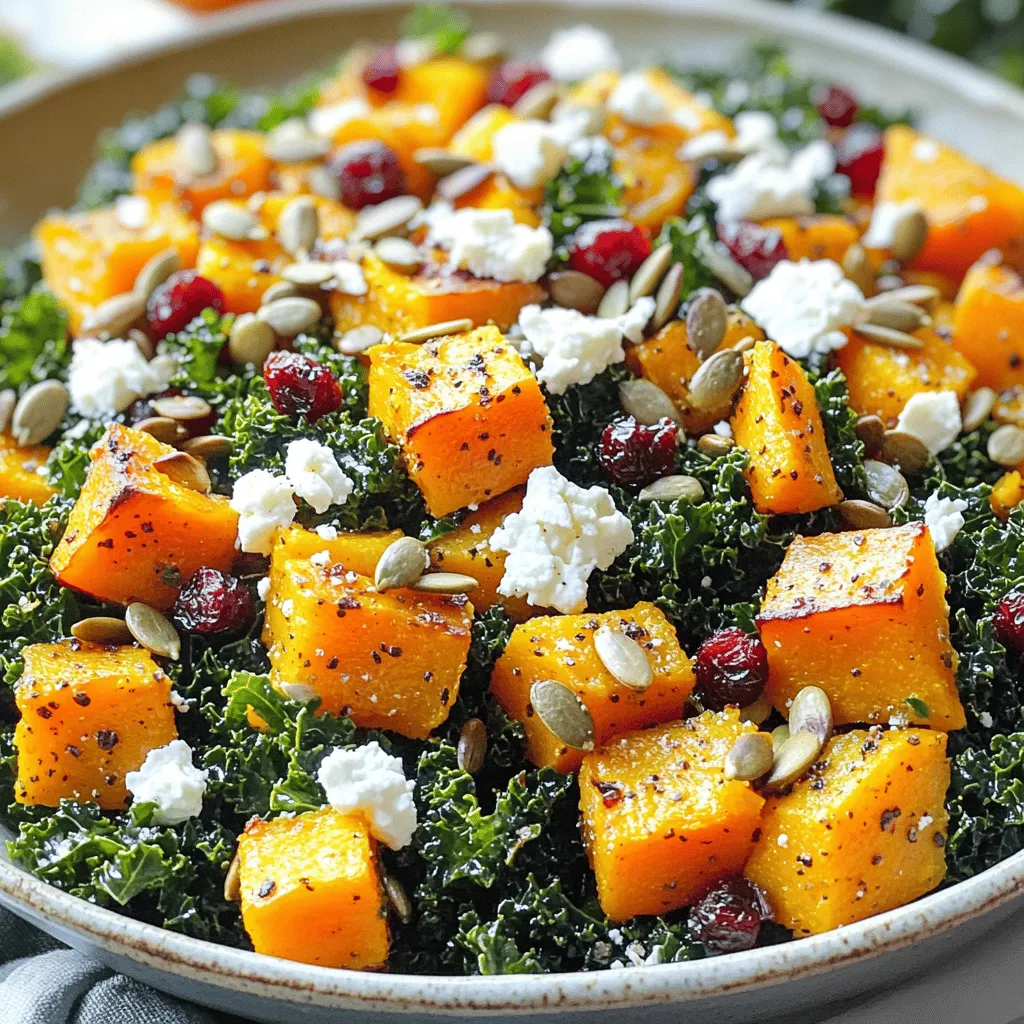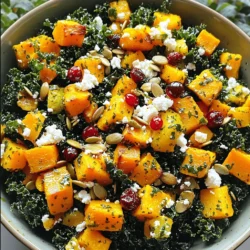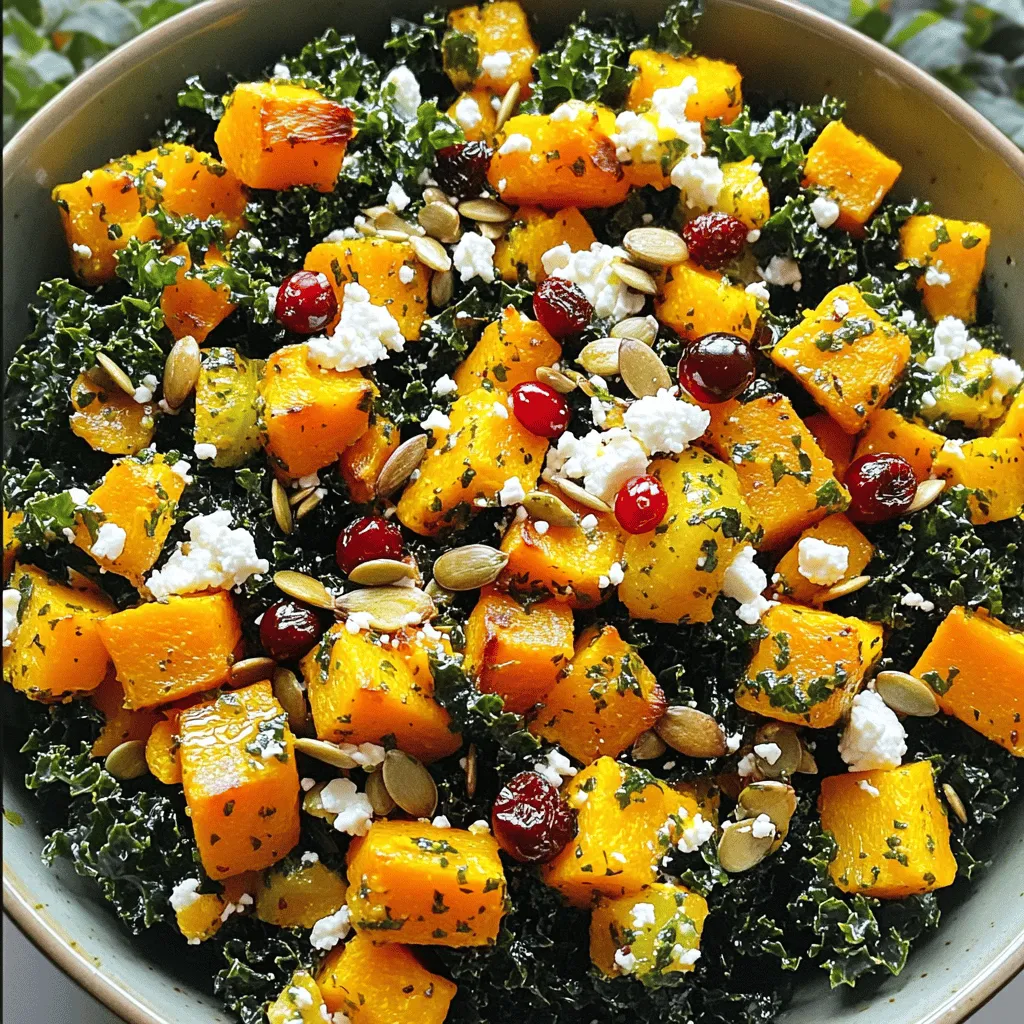Looking for a fresh and tasty dish? My Butternut Squash Kale Feta Salad is just what you need! This vibrant salad combines sweet butternut squash, nutrient-rich kale, and tangy feta cheese for a meal that’s both fun and healthy. Whether you’re meal prepping for the week or hosting a dinner party, this recipe offers easy steps, helpful tips, and variations to delight your taste buds. Let’s dive into making this delightful dish!
Ingredients
List of Ingredients
- 1 medium butternut squash, peeled and cubed
- 3 cups kale, stems removed and leaves chopped
- 1/2 cup feta cheese, crumbled
- 1/4 cup toasted pumpkin seeds
- 1/4 cup dried cranberries
- 2 tablespoons olive oil
- 1 tablespoon maple syrup
- 1 tablespoon apple cider vinegar
- Salt and pepper to taste
- 1 teaspoon cinnamon
Optional Ingredients
- Other nuts for added crunch
- Different cheese like goat cheese
- Fresh herbs like parsley or basil
Nutritional Information per Serving
- Calories: 250
- Protein: 8g
- Fat: 15g
- Carbohydrates: 28g
- Fiber: 5g
- Sugar: 6g
Step-by-Step Instructions
Preparation of Butternut Squash
Start by preheating your oven to 400°F (200°C). Next, peel the butternut squash and cut it into cubes. Take a bowl and toss the cubed squash with 1 tablespoon of olive oil, cinnamon, salt, and pepper. Make sure every piece gets coated. Spread the squash on a baking sheet in a single layer. Roast it in the oven for 25 to 30 minutes. Flip the squash halfway through. It should be tender and caramelized when done.
Preparing the Kale
While the squash roasts, you can prepare the kale. First, remove the tough stems and chop the leaves. In a large bowl, mix the chopped kale with the remaining olive oil, maple syrup, apple cider vinegar, salt, and pepper. Now, use your hands to massage the kale for about 1 to 2 minutes. This helps to soften the leaves. It will make the kale more tasty and easy to chew.
Combining Ingredients
Once the butternut squash is done, let it cool for a few minutes. Add the roasted squash to the bowl with the kale. Then, add the crumbled feta, toasted pumpkin seeds, and dried cranberries. Gently toss everything together until it’s well mixed. Taste and adjust the seasoning if you need more salt or pepper. You can serve this salad right away. If you want, chill it in the fridge for up to an hour. This helps the flavors blend together nicely.
Tips & Tricks
Best Practices for Roasting Butternut Squash
Roasting butternut squash brings out its natural sweetness. Here are my top tips:
- Choose the right squash: Pick a medium squash that feels heavy for its size.
- Peel and cube: Use a sharp knife to peel and cut it into even cubes.
- Season well: Toss the cubes in olive oil, cinnamon, salt, and pepper for flavor.
- Single layer: Spread the cubes on a baking sheet in a single layer. This helps them roast evenly.
- Flip halfway: Turn the squash midway through cooking to caramelize all sides.
How to Massage Kale Properly
Massaging kale makes it softer and tastier. Follow these steps:
- Remove stems: Strip the leaves from the tough stems and chop them.
- Add oil and vinegar: In a bowl, mix kale with olive oil, apple cider vinegar, salt, and pepper.
- Use your hands: Rub the kale leaves gently for 1-2 minutes. This breaks down the tough fibers.
- Check softness: The kale should become darker and more tender after massaging.
Serving Suggestions for Enhanced Flavor
A few tweaks can elevate your salad:
- Extra feta: Sprinkle more feta on top for a creamy burst.
- Pumpkin seeds: Add a handful for crunch and a nutty taste.
- Cranberry garnish: Use dried cranberries to add color and sweetness.
- Serve chilled: Let the salad sit for an hour in the fridge before serving. This helps flavors blend beautifully.

Variations
Substitutions for Dietary Restrictions
If you have a dairy allergy, use a vegan feta or omit it. For nut allergies, skip the pumpkin seeds. You can add sunflower seeds instead for a similar crunch. If you follow a gluten-free diet, rest assured, this salad is already gluten-free. You can also swap apple cider vinegar for lemon juice if needed.
Seasonal Variations
This salad shines all year. In spring, add fresh peas or asparagus. For summer, toss in cherry tomatoes for color. In fall, use roasted sweet potatoes instead of butternut squash. In winter, consider adding some sliced apples for a refreshing crunch.
Adding Protein Sources
To make this salad a full meal, add protein. Grilled chicken or turkey pairs well with the flavors. You can also use chickpeas for a vegetarian option. Tofu or tempeh works great too. For a seafood twist, top with shrimp or salmon.
Storage Information
How to Store Leftovers
To keep your salad fresh, place it in an airtight container. This will help prevent it from wilting. Store it in the fridge. It stays good for about 3 days. If you have extra dressing, store it separately. This keeps the kale crisp and tasty.
Reheating Tips
You don’t need to reheat this salad. It tastes best cold. If you want warm squash, heat it in the microwave. Use a safe bowl and heat in short bursts. Stir in between to avoid hot spots.
Shelf Life of Ingredients
- Butternut Squash: Lasts about a week if stored in a cool, dry place.
- Kale: Stays fresh for around 5 days in the fridge.
- Feta Cheese: Good for about 4-6 weeks if unopened. Once opened, use it within a week.
- Pumpkin Seeds: Keep for up to 6 months in a cool, dark spot.
- Cranberries: Last for about a year if stored in a sealed bag.
Understanding how to store your ingredients helps minimize waste. Enjoy your salad longer and keep it delicious!
FAQs
Can I make this salad ahead of time?
Yes, you can make this salad ahead of time. However, the best taste comes when you eat it fresh. If you prepare it early, keep the dressing separate. This helps the kale stay crisp. Mix everything just before serving for the best flavor.
What can I substitute for feta cheese?
If you want a feta substitute, try goat cheese or a vegan option. Both add creaminess and flavor. You can also use ricotta for a different taste. Choose what you like best to make this salad your own!
Is this salad suitable for meal prep?
Yes, this salad is great for meal prep. You can store each part separately. Keep the roasted squash, kale, and toppings in different containers. This keeps them fresh and tasty. When ready to eat, just combine everything in a bowl. Enjoy your meal anytime!
This article covered how to make a tasty butternut squash and kale salad. We discussed ingredients, from the main items to optional ones. I shared tips for roasting squash and massaging kale, plus serving ideas. You learned about variations, storage, and meal prep questions.
This dish is easy to make and great for your health. Don’t hesitate to try different ingredients and make it your own. Enjoy a fresh, nutritious meal today!


